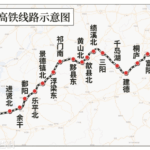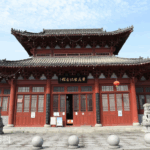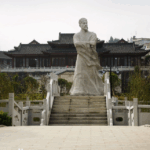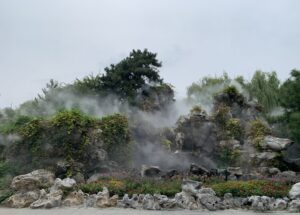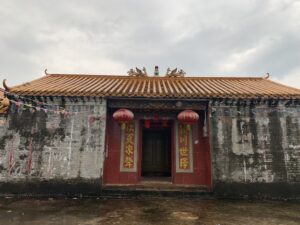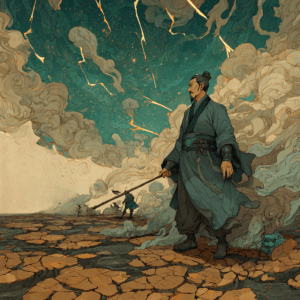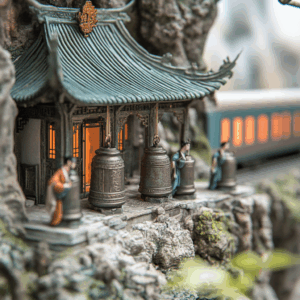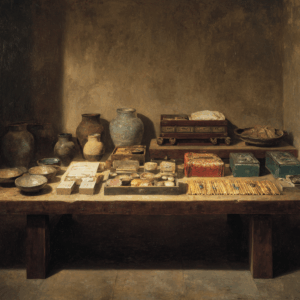一縷微腥的香,穿越水雲與書案之間。
不是每種香氣都天生馥郁,有些必須經歷煎熬與淬火,才顯清芬。
本篇探尋的是「黃庭堅與螺甲香」交織的幽微篇章。黃庭堅是宋代文壇巨擘,江西詩派之祖,更被後世尊為「香聖」。
在千帆過盡的詩卷之外,他以一縷縷焚香的煙霞,洗練心魂、鍛煉性情。螺甲香,是靈魂的修練。香煙繚繞間,他以筆作舟,渡過現實的滄浪,也讓一抹海的氣息,融入了詩心與夢境。
香徑其地|贛江畔的詩魂
贛南,既是黃庭堅的流放之地,也是他精神蛻變的香學之徑。
在贛江畔,他焚香靜坐,遠離朝堂喧囂,與空性為伍。螺甲香的特性——陰中有陽、腐中出香,彷彿也是一帖他寫給自己心靈的安慰劑。
古人言:「香可清心,亦可照影。」
螺甲香需在烈火中浴火重生,而黃庭堅亦在貶途中寫下無數不朽詩篇。他說:「清風徐來,水波不興」,但那一縷香氣卻已穿過千年書卷,仍在贛江一隅悄悄浮動。
香學其義|螺甲不香,故能成香
現代合香講究君臣佐使,古人則更講究香料的性格與轉化。
螺甲香不是天生馥郁之物,反而帶有一種孤傲與抵抗。
它像黃庭堅一樣,不肯隨俗、不輕與合,卻在長久的隱忍與修煉中,自成風骨。
香不是用來討喜的,是用來見證的——見證時間如何從雜質中煉出本真。
沿香而行|香徑與文脈的連結
若你自南昌出發,乘坐贛深高鐵,抵達贛州,步入黃庭堅流放之地——
這不只是文學朝聖,更是一場嗅覺與詩心的覺醒之旅。
你可以走訪黃庭堅紀念館、步入賜閣巷,在舊屋中嗅聞微弱香氣的迴音。那不是蠟燭香,也不是花露香,而是來自一千年前詩人案上燃起的「螺甲沉香」。
結語|香若其人,人如其香
黃庭堅說:
「欲雨鳴鳩日永,下帷睡鴨春閒。」
他看似戲言,卻道出焚香清供、與天地並坐的閒情逸致。
螺甲香不是濃烈之香,它的存在如同詩人遺世的文字,淡而不薄、隱而不滅。
千年之後,我們在鐵道與文字之間,仍可尋見那縷「百煉」之香。它從江南出發,繞過風塵與權謀,最終留在一頁詩後、一封煙雨南行的舊信裡。
黃庭堅:《有惠江南帳中香者戲贈二首》
他自號「山谷道人」,一生宦游顛沛,屢遭貶謫,但也因此與香結緣,沉靜於焚香書畫之境。
在《有惠江南帳中香者戲贈二首》中,他寫道:
「百煉香螺沉水,寶熏近出江南。
一穗黃雲繞几,深禪想對同參。」
「螺甲割匀焚耳,香材周磨拂塵。
欲雨鳴鳩日永,下帷坐對香爐。」
譯文:
歷經百煉的香螺沉入水中,名貴的香料出自江南。。
一縷金黃煙霧繞著案几,靜坐參禪之時與友人共悟。
將螺甲整齊切割焚燒,香料圓潤細磨以去塵垢。
天將下雨,鳴鳩長鳴,我垂簾靜坐,對著香爐冥想。
他所說的「螺甲香」,正是從南海貝螺提煉而成的香料,原本氣味腥臭,需經炮炙焚煉、搭配諸香調和,方能顯出幽微清芬——這種由腐轉芳的質變,恰恰呼應了黃庭堅的人生哲學:熬過萬難,才能返璞歸真。
Sie sehen gerade einen Platzhalterinhalt von YouTube. Um auf den eigentlichen Inhalt zuzugreifen, klicken Sie auf die Schaltfläche unten. Bitte beachten Sie, dass dabei Daten an Drittanbieter weitergegeben werden.
Mehr Informationen從杭州到南昌,一段串聯名城名山的黃金旅程
杭昌高速鐵路是一條連接浙江杭州、安徽黃山與江西南昌的高速鐵路,全長約560公里,設有18座車站,最高營運時速達350公里,是中國「八縱八橫」高速鐵路網的重要支線之一。
旅客可從杭州南站出發,經千島湖、黃山、景德鎮、鄱陽湖,最終抵達南昌東站,全程風光絕美。這條黃金旅遊線路沿線串聯西湖、富春江、黃山、鄱陽湖、滕王閣等國內知名5A級景區,是遊覽江南與贛鄱的首選。
沿線車站融合了徽派建築、人文設計與現代功能,尤其杭黃段,更像是行駛在畫卷中的旅程。杭昌高鐵不僅大幅縮短了杭州至南昌的交通時間,也開啟了浙江西部富陽、桐廬等地的高鐵時代。
目前,江西段已啟用「鐵路e卡通」、約號進站等智慧交通服務,還推出了30日定期票與20次計次票,為常旅客提供更多彈性選擇。
無論是賞湖遊山、探索人文古鎮,或是體驗現代高鐵之便,杭昌高鐵都將為您開啟一段悠然的文化之旅。
資料來源:杭昌高速铁路
和諧號 CRH380A 型電力動車組

和諧號 CRH380A 型電力動車組(又稱 CRH2-380 型),是中國專為時速 350 公里等級高速鐵路設計的第二代高速列車,由中車青島四方機車公司在原 CRH2C 型基礎上研發而成,採用鋁合金空心型材車體,結構輕巧、安全穩定。
此車型經本土化改進,成為中國首批實現時速 350 公里商業營運的高鐵列車之一。自 2009 年起,時任鐵道部向南車青島四方採購共 140 列此型號列車(含長短編組),總值約 450 億人民幣。
CRH380A 採用動力分散設計,列車牽引能力更強、提速更快,最高測試時速超過 400 公里,滿足京滬高鐵等高標準路線的需求。車體外型經空氣動力學優化,行駛時更為平穩安靜,是現代中國高鐵速度與科技的代表作之一。
資料來源:和谐号CRH380A型电力动车组
📜 本作品已提交版权保护程序,原创声明与权利主张已公开。完整说明见:
👉 原创声明 & 节奏文明版权说明 | Originality & Rhythm Civilization Copyright Statement – NING HUANG
节奏文明存证记录
本篇博客文为原创作品,由黄甯与 AI 协作生成,于博客网页首发后上传至 ArDrive 区块链分布式存储平台进行版权存证:
- 博客首发时间:请见本篇网页最上方时间标注
- 存证链接:aabaad0e-eaf8-4077-83b6-b0381c0711c1
- 存证平台:ArDrive(arweave.net)(已于 2025年7月5日 上传)
- 原创声明编号:
Rhythm_Archive_05Juli2025/Rhythm_Civilization_View_Master_Archive
© 黄甯 Ning Huang, 2025. All Rights Reserved.
本作品受版权法保护,未经作者书面许可,禁止复制、改编、转载或商用,侵权必究。
📍若未来作品用于出版、课程、NFT或国际展览等用途,本声明与区块链记录将作为原创凭证,拥有法律效力。
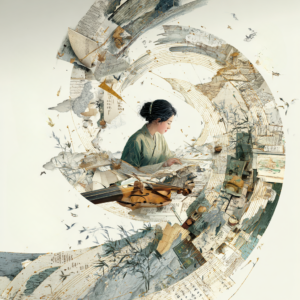
《模组型体质的学习法:以节奏为师,以身体学习文明》
这篇〈模组型体质的学习法〉是我第一次认真回望,我这一生到底是怎样学习的。事实上,我的学习并不是只有直觉,也不是不用头脑,而是:身体先感到,头脑才开始理解;直觉先开门,思考随后把结构建起来。每当我进入一个陌生领域,我不是从概念开始,而是从感受与节奏开始——一旦身体抓到节奏,头脑便能迅速组织、推理、整合。无论是乐器、戏曲、香气、工艺、文学,或是楚文明的六十篇写作,我的路径始终一样:感知点亮入口,思考完成结构,文明在两者之间自动显形。我终于明白:我学习的不只是知识,而是世界如何运作。
This essay is my first honest attempt to understand how I have learned throughout my life. My learning has never been purely intuitive, nor purely intellectual. The order is simply different: the body senses first, and the mind understands afterward. Intuition opens the door; thinking builds the structure. Whenever I enter a new field, I do not begin with concepts but with sensation and rhythm—once my body catches the rhythm, my mind can quickly organize, reason, and integrate. Whether in instruments, opera, scent, craft, literature, or the sixty essays on Chu civilization, the pattern remains constant: sensation lights the entry, intellect completes the architecture, and the structure of a civilization emerges between the two. Only now do I realize that I was never learning “knowledge” alone—I was learning how the world works.

《我的人生,是一部楚居——一个非线性学习者的迁徙与文明回归》
这是一篇以《楚居》的逻辑重新阅读人生的个人叙事:七所大学、七个科系、七座城市、七种工艺、七种乐器的迁徙与学习经验。那些曾被视为“分散”的路径——学业、城市、工艺、音乐——在楚人的徙居节奏中重新排版,显现为一个非线性学习者独特的生命结构。由此展开一条“迁徙与文明回归”的路径:漂泊不再是迷失,而是一种自我命名的方式,让生命的多声部共同指向同一个根。
This essay rereads a life through the logic of Chu-Ju: seven universities, seven disciplines, seven cities, seven crafts, and seven musical instruments—each a trace of migration and learning. What once appeared as scattered paths—academia, geography, craft, and music—rearranges itself through the Chu rhythm of continual relocation, revealing the underlying structure of a nonlinear learner’s life. From this emerges a journey of migration and civilizational return: wandering becomes not a sign of being lost, but a form of self-naming, allowing the many voices of a life to point toward the same root.

《楚文明导航地图》| 五种呼吸,六十缕光
《楚文明导航地图》是一张由六十缕光织成的文明呼吸谱。
当竹简沉睡两千年再度被展开,我们听见的不只是制度、制度、事件,而是一座文明在黑暗中、在风中、在火中、在歌声里,缓缓调息的方式。
这张地图将六十篇楚简新读重新归于五种生命节律——元息、脉息、气息、共息、声息——宛如文明的五种呼吸。
它们不是分析框架,而是古人观看世界的方式,也是我们重新学会呼吸的入口。
从宇宙胎动的第一缕微光,到四季脉动的心跳;从人心的隐语、情绪的暗流,到千万人共享的一口气;从风中的美学,到穿越时间的歌声——
楚文明告诉我们:
文明的延续,不靠征服,而靠呼吸。
人生的安顿,不靠效率,而靠节奏。
愿这张地图成为你走回源头的一盏灯,
也成为你在喧嚣时代里,重新找到自己的——呼吸之道。
“A Navigation Map of Chu Civilization” is a breathing chart woven from sixty beams of ancient light.
When bamboo slips, asleep for two millennia, are unfolded again, what emerges is not merely history or governance, but the quiet rhythm of a civilization learning to breathe—
in darkness, in wind, in fire, in song.
This map gathers sixty essays into five life-breaths of Chu culture—
Primordial Breath, Seasonal Pulse, Human Breath, Shared Breath, Resonant Breath.
They are not analytical categories but ancient modes of perceiving the world—and an invitation for us to breathe again.
From the first tremor of the cosmos to the pulse of the seasons;
from the subtle syntax of the body to the storms of emotion;
from the shared breath of a nation to the beauty that travels through time—
Chu civilization whispers:
A civilization endures not by conquest, but by breath.
A life becomes whole not by speed, but by rhythm.
May this map be a lantern guiding you back to the source—
and a compass for rediscovering
your own way of breathing
in an age that forgets to breathe.
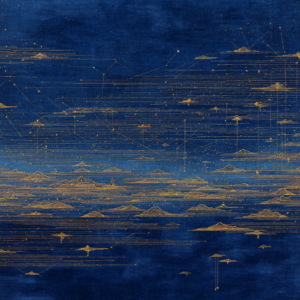
《竹简轻响:在清华简〈参不韦〉中,听见文明的心跳》
本篇文章循着竹简上的轻响,走进清华简《参不韦》的世界。我们不再将其视为古老训诫,而是聆听一部文明自身的“心跳记录”——从启动文明的第一行代码“五则”,到架构社会的呼吸与脉动;从身体与天地法则的精密对应,到九种让文明窒息的低语;最终,抵达那份“山渊之喻”中蕴藏的、关于平衡与持久的古老智慧。
这是一次与战国楚人的深度对话,他们留下的不是答案,而是一套让文明在时间中“持续呼吸”的系统思维。在速度至上的今天,这份竹简悄然提问:当一切都在狂奔,我们是否还记得,如何听见并守护一个文明最深沉、最根本的心跳?
This essay follows the faint rustle of bamboo slips and enters the world of the Tsinghua manuscript Can Buwei. We no longer read it as an ancient admonition, but as the “heartbeat record” of a civilization itself—beginning with the first line of code that boots a world, the Five Principles; moving through the breath and pulse of social architecture; tracing the precise correspondences between the human body and cosmic law; listening to the nine low whispers that suffocate a civilization; and finally arriving at the “Parable of Mountain and Abyss,” where an older wisdom of balance and endurance resides.
This is a deep conversation with the people of Warring States Chu. What they left us is not a set of answers, but a way of thinking—a system that allows a civilization to keep breathing across time. In an age that worships speed, these bamboo slips pose a quiet question: when everything is rushing forward, have we forgotten how to hear, and how to protect, the deepest and most essential heartbeat of a civilization?
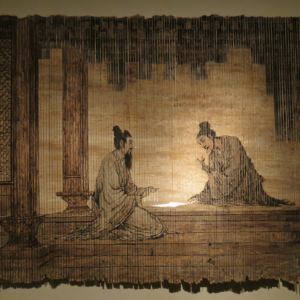
《败军之将的逆袭圣经:上博简〈曹沫之陈〉里的”弱国兵法册”》
《曹沫之陈》呈现的不是战场技艺,而是一套由失败逼出的治理哲学。竹简将“三战三败”的经验转化为结构性洞察:军事溃败源自政治偏离,逆袭必须从制度与德政的重建开始。文中批评“面子工程”、强调“修政善民”、破除宿命论、以德性重构国家的核心竞争力,其思想结构与安大简等楚系文献所体现的“德—政—治”框架高度同构。本文以文献互证的方式,展示春秋时期弱国如何通过自省与治理改革重获战略主动权;并指出真正的胜负,从不是战场决定,而是政治系统决定。
Cao Mo zhi Chen is not a treatise on battlefield tactics but a work of governance extracted from repeated defeat. The text reframes military failure as a symptom of political dysfunction and positions systemic reconstruction—rather than stratagem or force—as the basis for national resurgence. Its critique of vanity projects, emphasis on internal governance, rejection of fatalism, and insistence on virtue as political capital closely parallel the “Virtue–Governance–Order” structure seen in the Anhui University Chu manuscripts. Through cross-textual analysis, this essay demonstrates how weak states in the Spring and Autumn period regained strategic agency through introspection and reform, revealing that the true determinants of victory lie not on the battlefield but within the political system itself.
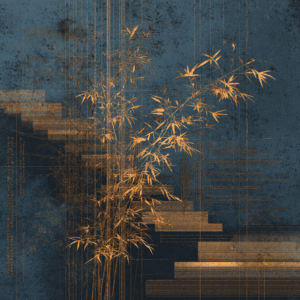
《楚国的”建国大纲”与”公务员手册”|上博简〈天子建州〉〈从政〉》
本篇文章以上博简《天子建州》《从政》为中心,对楚国政治思想中的“体用合一”治理结构进行系统性分析。《天子建州》展现了楚国王权秩序的顶层设计,可视为早期的“建国大纲”;《从政》则呈现从政者的品德规范与用人法度,具有“公务员手册”的性质。文章透过简文对“礼”“文德与武德”“五德”“言行一致”“君子与小人”的讨论,将先秦政治哲学与现代治理困境进行互文式对读,指出形式主义、信任危机、干部能力落差等现代问题的根源。本文试图透过两篇楚简重新思考制度与人的关系,提出技术理性与价值理性的双轨整合,是良好治理的关键。
This article examines the governance philosophy embedded in the Shanghai Museum Chu Bamboo Slips Tianzi Jianzhou (“The King Establishes the Domains”) and Congzheng (“On Serving in Office”). Tianzi Jianzhou outlines the constitutional blueprint of political order—analogous to an early “founding charter”—while Congzheng articulates the ethical standards and behavioral norms of officials, functioning as a “civil service manual.” Through a close reading of key concepts such as ritual authenticity, the balance between civil and martial governance, the Five Virtues of officials, integrity in action and speech, and the contrast between the gentleman and the petty man, this article places ancient Chu political thought in dialogue with contemporary governance challenges, including formalism, trust deficits, and competence gaps in public administration. It argues that effective governance requires the integration of institutional design (“ti,” the body) and human conduct (“yong,” the use), as well as a balance between technical rationality and value rationality.


